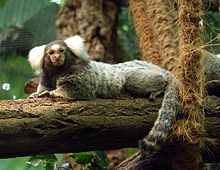Callithrix jacchus
| Common marmoset | |
|---|---|
 |
|
| Scientific classification | |
| Kingdom: | Animalia |
| Phylum: | Chordata |
| Class: | Mammalia |
| Order: | Primates |
| Family: | Callitrichidae |
| Genus: | Callithrix |
| Species: | C. jacchus |
| Binomial name | |
|
Callithrix jacchus (Linnaeus, 1758) |
|
 |
|
| Geographic range | |
| Synonyms | |
|
|
The common marmoset (Callithrix jacchus) is a New World monkey. It originally lived on the Northeastern coast of Brazil, in the states of Piaui, Paraiba, Ceará, Rio Grande do Norte, Pernambuco, Alagoas and Bahia. Through release (both intentional and unintentional) of captive individuals, it has expanded its range since the 1920s to Southeast Brazil (its first sighting in the wild for Rio de Janeiro was in 1929) and became there an invasive species, raising concerns about genetic pollution of similar species, such as the buffy-tufted marmoset (Callithrix aurita), and predation upon bird nestlings and eggs.
The whole-genome sequence of a female common marmoset was published on 20 July 2014. It became the first New World Monkey to have its genome sequenced.
Common marmosets are very small monkeys with relatively long tails. Males and females are of similar size with males being slightly larger. Males have an average height of 188 mm (7.40 in) and females have an average height of 185 mm (7.28 in). Males weigh 256 g (9.03 oz) on average and females weigh 236 g (8.32 oz) on average. The pelage of the marmoset is multicolored, being sprinkled with brown, grey, and yellow. It also has white ear tufts and the tail is banded. Their faces have black across there nose area skin and have a white blaze on the forehead. The coats of infants are brown and yellow coats with the ear tuft developing later.
As with other members of the genus Callithrix, the common marmosets have claw-like nails known as tegulaes on most of their fingers. Only their halluxes (big toes) have the flat nails or ungulaes that most other primates have. Marmosets have an arboreal locomotion similar to squirrels. They can hang on to trees vertically and leap between them, as well as run across branches quadrupedally. Tegulaes are an adaptation of this type of locomotion. Other Callithrix traits shared include enlarged, chisel-shaped incisors and specialized cecums for their diet.
...
Wikipedia

